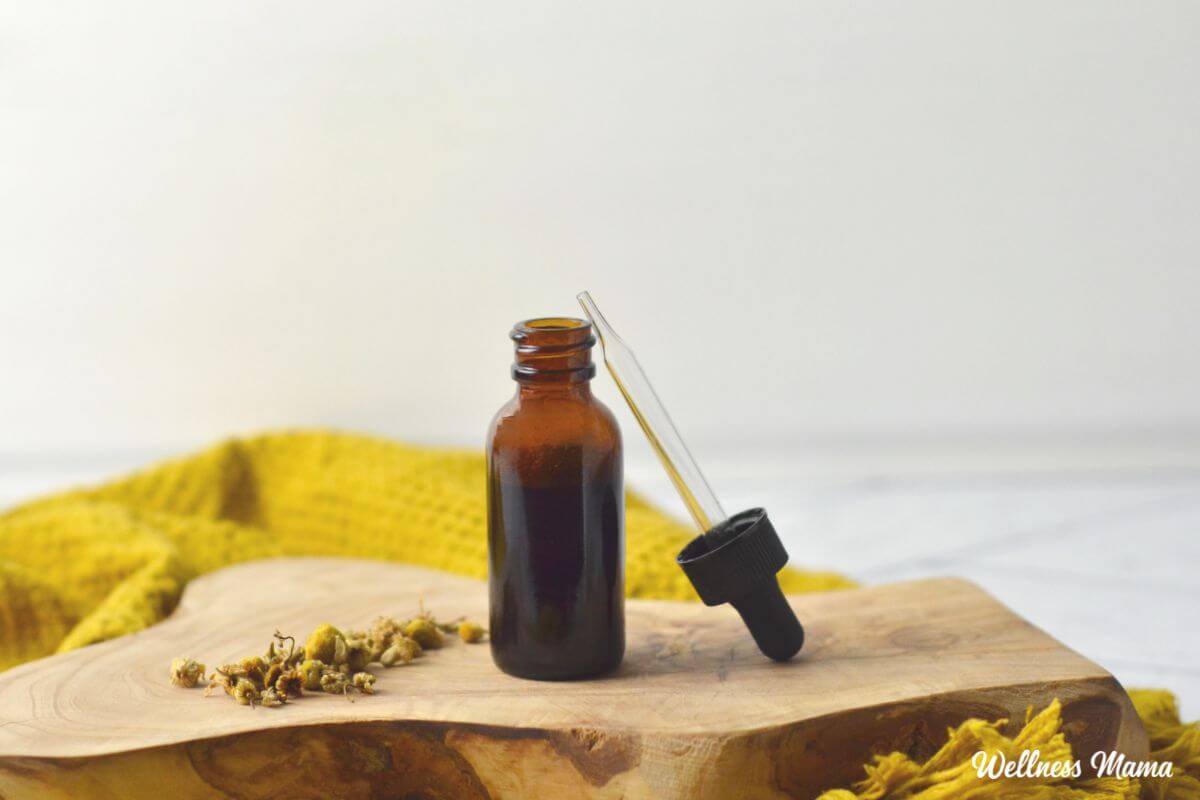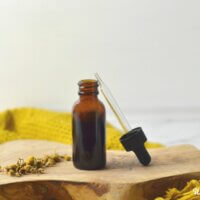Chamomile is one of my favorite herbs because of its delicate scent and great taste in teas. It is my absolute favorite herb for kids and I keep a tincture of chamomile on hand for any childhood aches and ailments.
Switching to a real food diet has eliminated our bouts with ear infections and stuffy noses (though chamomile helps with those too!) but some things, like teething pain, can’t be fixed with healthy food!
Chamomile Tincture
The type of chamomile I use in herbal tinctures is German chamomile, also known as Matricaria chamomilla, chamomilla recutita, or Matricaria recutita. Roman chamomile is also available, but it’s not used as often and has a different taste. The different chamomiles also have slightly different properties so I’m just going to focus on German chamomile here.
How to Use Chamomile
Chamomile is a naturally calming herbal remedy that relaxes nerves and reduces pain. Its been known to settle the stomach and reduce gas and colic in infants. I use it to soothe fussy babies, calm down upset toddlers, and on bruises.
Adults can use chamomile as a sleep aid, to ease menstrual cramps, relieve headaches, for digestive health and soothe frayed nerves. It’s also great for the skin, especially eczema, and can even naturally lighten hair. Chamomile helps support the nervous system and may boost the immune system.
A small trial found that chamomile can help soothe the pain and stiffness from osteoarthritis. Much like turmeric, chamomile can help with inflammation. The liquid extract contains antioxidant flavanoids, like apigenin that help fight inflammation and improve sleep.
Chamomile tea is one of the most popular herbal teas, but sometimes it’s just faster to grab a tincture. A homemade chamomile tincture is incredibly easy to make and is my favorite baby gift for new parents. I take it to the hospital when I have a baby (mainly for me during labor!).
Homemade Chamomile Tincture
Materials
- 1 cup chamomile flowers
- 3-4 cups vodka or rum at least 80 proof
Instructions
- Pack the chamomile flowers into a clean quart-size glass jar. If preferred, you can run the entire mixture (alcohol and chamomile) through the blender first. This increases the surface area of the herb for better extraction.
- Fill the rest of the jar with vodka or rum (do not use rubbing alcohol or non-consumable alcohol!) and tightly cover with an airtight lid. If using fresh chamomile instead of dried, then use 190 proof alcohol.
- Store in a cool, dark place and shake daily for 2-4 weeks. This will make a strong tincture! Add more alcohol if necessary to make sure the chamomile stays covered during this process.
- After 2-4 weeks, remove from the cabinet, and pour through a cheesecloth or strainer. Store in a jar or in dropper bottles for easy use.
Notes
Alcohol-free Chamomile Extract
Not everyone wants a chamomile herbal extract made with alcohol. Herbal glycerites use vegetable glycerin instead and are another option. While I feel safe giving chamomile tinctures even to my babies and little ones, here’s how to make a glycerite if you want that option.
Chamomile Tincture Dosing
- Infants: only a few drops are needed. Often it can be rubbed on the gums or stomach for teething or colic pain.
- Toddlers and older children: 1/4 to 1/2 teaspoon can be taken 1-3 times a day while needed. It’s especially useful for babies and young children who are having difficulty sleeping. A dose right before bedtime can help relax and soothe them for a more peaceful sleep.
- Adults: up to 1 teaspoon, 1-3 times a day as needed.
Any herb can be preserved with this method, and often this is the most cost-effective way to use herbs. I grow a lot of my own herbs, but I’ll get organic chamomile or other herbs from here if it’s not in my garden.
Chamomile Tincture Variations
Sometimes I’ll tincture a single herb, but having some blends on hand is also nice. Chamomile also blends well with catnip, lemon balm, peppermint, or fennel. Catnip and lemon balm are both calming nervines. Peppermint and fennel help soothe digestive upsets.
Another tincture I keep on hand is my homemade Herbal Digestive Remedy Tincture. This one uses both peppermint and fennel, but you could add some chamomile too. The nice thing about homemade herbal supplements is I can customize them to my exact needs!
This article was medically reviewed by Jessica Meyers, MPAP, PA-C, RH(AHG), who specializes in herbal protocols and functional medicine. You can also find Jessica on Instagram. As always, this is not personal medical advice and we recommend that you talk with your doctor.
What homemade tinctures do you make? Share below!





Leave a Reply